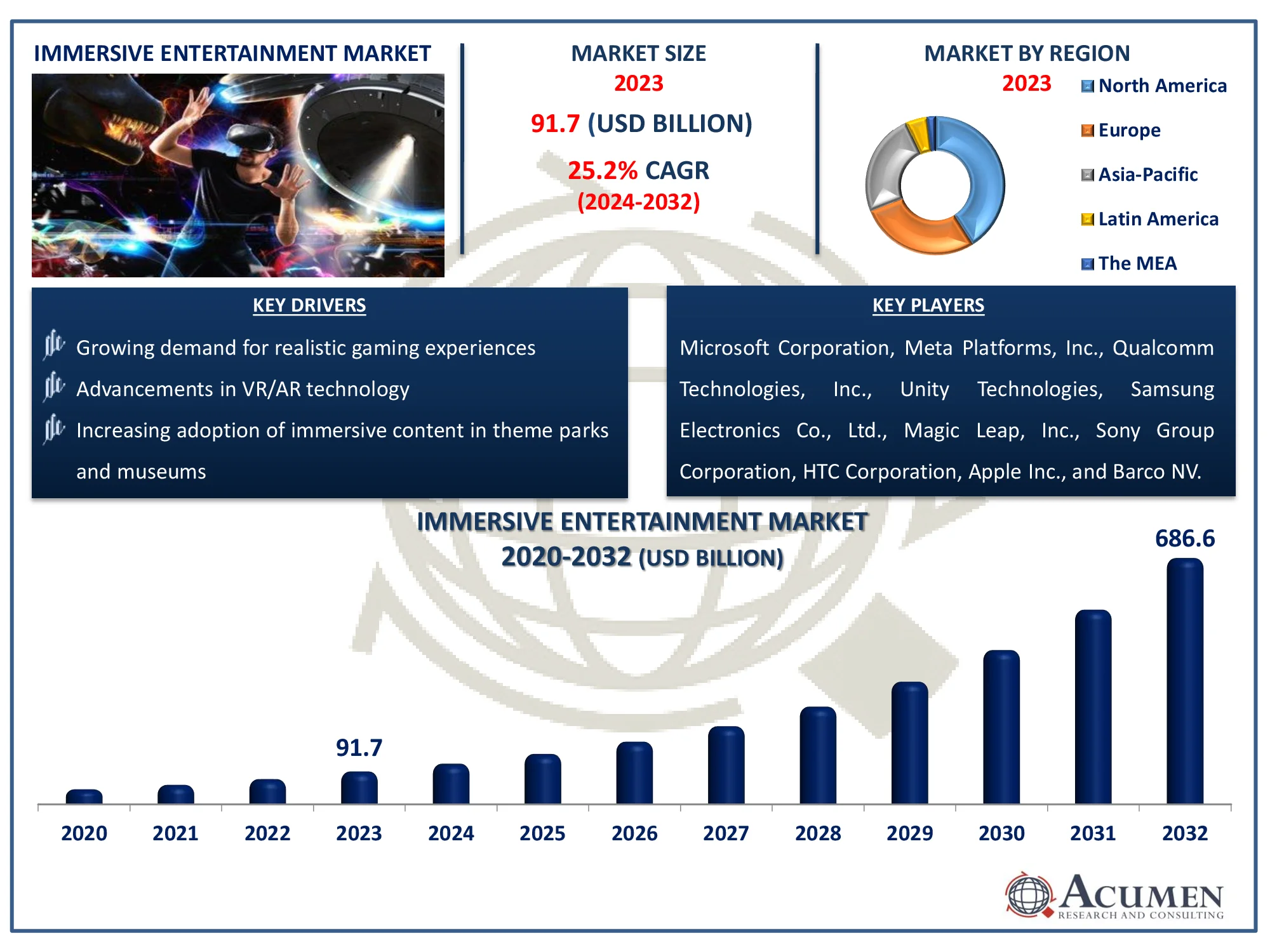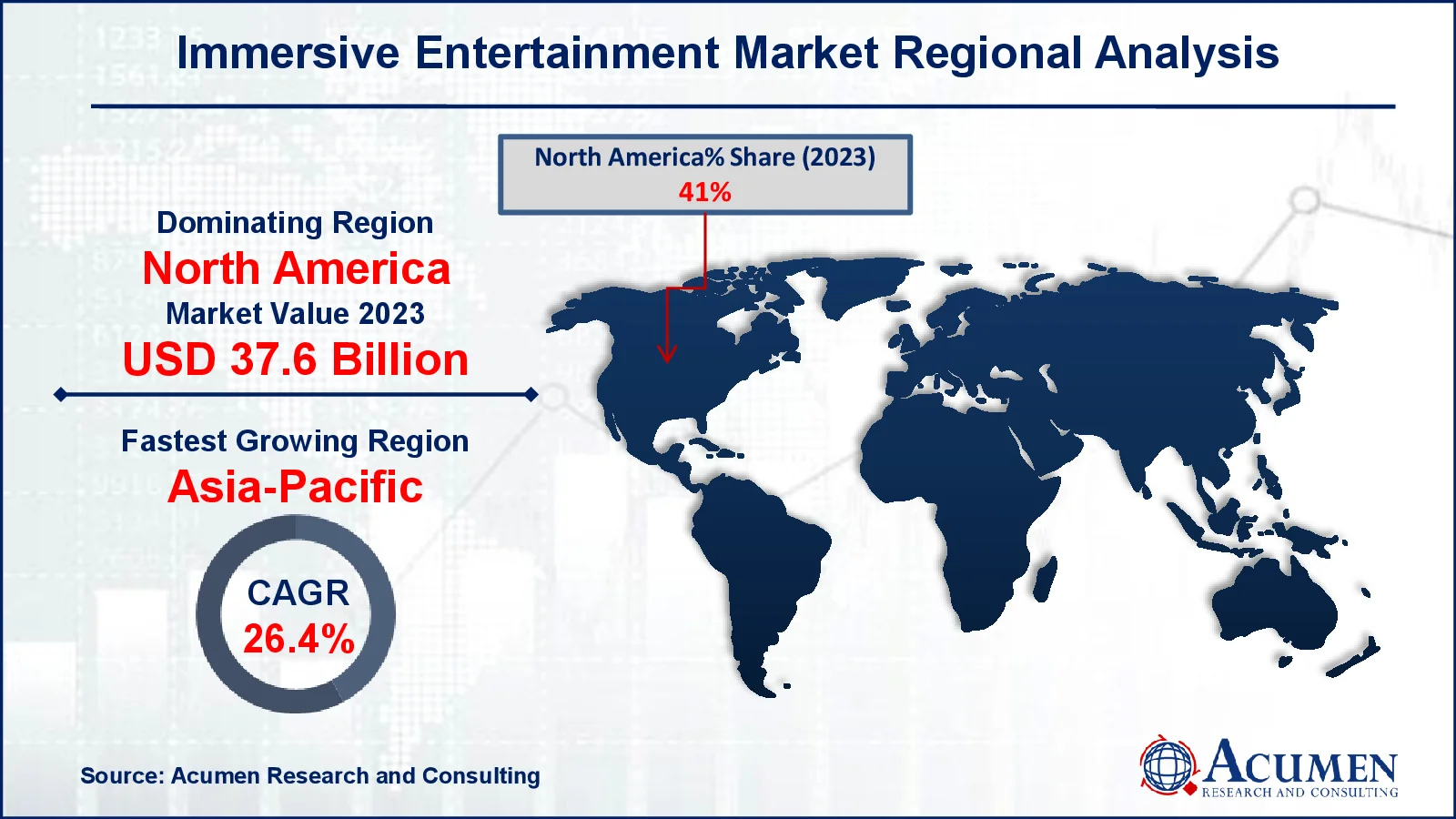November 2022
The Global Immersive Entertainment Market Size accounted for USD 91.7 Billion in 2023 and is estimated to achieve a market size of USD 686.6 Billion by 2032 growing at a CAGR of 25.2% from 2024 to 2032.
The Global Immersive Entertainment Market Size accounted for USD 91.7 Billion in 2023 and is estimated to achieve a market size of USD 686.6 Billion by 2032 growing at a CAGR of 25.2% from 2024 to 2032.

Immersive entertainment is a type of digital experience that completely engages the senses, making users feel like they are a part of the story or setting. It uses cutting-edge technology such as virtual reality (VR), augmented reality (AR), and mixed reality (MR) to create interactive, 3D experiences. These experiences can include virtual concerts, interactive theme parks, virtual reality games, and immersive theater.
The National Institute of Health (NIH) found that 62.7% of students spend more than 30 hours per week playing online games. The data also indicate that male pupils are more likely than female students to exhibit indicators of addiction. As a result, gaming's popularity among the younger generation adds to the growth of the immersive entertainment industry in the anticipated year.
|
Market |
Immersive Entertainment Market |
|
Immersive Entertainment Market Size 2023 |
USD 91.7 Billion |
|
Immersive Entertainment Market Forecast 2032 |
USD 686.6 Billion |
|
Immersive Entertainment Market CAGR During 2024 - 2032 |
25.2% |
|
Immersive Entertainment Market Analysis Period |
2020 - 2032 |
|
Immersive Entertainment Market Base Year |
2023 |
|
Immersive Entertainment Market Forecast Data |
2024 - 2032 |
|
Segments Covered |
By Technology Type, By Application, and By Geography |
|
Regional Scope |
North America, Europe, Asia-Pacific, Latin America, and Middle East & Africa |
|
Key Companies Profiled |
Microsoft Corporation, Meta Platforms, Inc., Qualcomm Technologies, Inc., Unity Technologies, Samsung Electronics Co., Ltd., Magic Leap, Inc., Sony Group Corporation, HTC Corporation, Apple Inc., and Barco NV. |
|
Report Coverage |
Market Trends, Drivers, Restraints, Competitive Analysis, Player Profiling, Covid-19 Analysis, Regulation Analysis |
Consumers are increasingly seeking immersive and engaging gaming experiences that blur the line between the virtual and real worlds. Virtuix unveiled the Omni One in March 2024, a 360-degree VR treadmill that includes a unique Pico 4 Enterprise headgear and a library of 35 compatible games. This arrangement provides gamers with an unparalleled immersive gaming experience due to flawless motion integration. The launch illustrates Virtuix's commitment to changing VR games through hardware innovation. As a result, the growing need for more realistic gaming experiences is moving the industry forward, inspiring key firms to develop ground-breaking technology. As a result, the gaming industry continues to be a significant growth driver for immersive entertainment.
Rapid technological advancements, such as higher graphics processing, improved motion tracking, and more comfortable wearable devices, drive the immersive entertainment sector ahead. According to the India Brand Equity Foundation, around 260 startups focused on AR/VR have emerged in India in recent years. These companies, which are backed by large manufacturers, are making immersive multimedia more appealing to a broader audience.
However, the high cost of VR/AR systems and peripherals remains a significant barrier to widespread adoption. Premium headsets, motion controllers, and haptic feedback systems are expensive, limiting access for high-income consumers and commercial users. This cost barrier restricts market expansion, especially in emerging economies where affordability is critical.
Immersive technologies are also gaining appeal in the education and training sectors, as they offer interactive and experiential learning opportunities. According to the Frontiers Organisation, immersive entertainment technologies encourage active and engaging learning in higher education. They let students visualize complex ideas, create interactive simulations, and practice practical skills in a controlled setting. This emerging use in education gives a promising growth opportunity for the immersive entertainment sector.
The worldwide market for immersive entertainment is split based on technology type, application, and geography.
According to the immersive entertainment industry analysis, virtual reality (VR) technology has dominated the business due to its capacity to create fully immersive and interactive experiences. VR enables users to explore virtual worlds by creating realistic 3D surroundings, increasing their sensation of presence and engagement. Its broad use in gaming, virtual tourism, live events, and cinematic experiences has added to its supremacy. Furthermore, constant developments in VR gear, such as high-resolution headsets and enhanced motion tracking, are making experiences more realistic, fueling consumer demand and cementing VR's market leadership.
According to the immersive entertainment market forecast, gaming sector is likely to dominate the market due to its early adoption and ongoing integration of advanced VR and AR technology. Major game firms are investing in VR-compatible consoles, headsets, and unique content, resulting in a fast rising user base. According to the EGROW Foundation, the online gaming business in India is predicted to generate ₹25,000 crore in investment by FY 2024. It now employs 100,000 people and is projected to increase to 150,000 by 2025. Furthermore, the growing popularity of multiplayer VR games and eSports is strengthening the gaming industry's dominance.
North America
Europe
Asia-Pacific
Latin America
The Middle East & Africa

For several reasons, North America dominates the immersive entertainment sector due to superior technical infrastructure, significant consumer spending, and a large presence of prominent tech companies such as Microsoft Corporation and Apple, Inc., which drive innovation. For example, in May 2023, Microsoft Corporation introduced the Immersive spaces feature for its Mesh platform. The new function would give consumers a more authentic experience when communicating with one other on the site. The regions mature market for VR, AR, and theme park experiences drives sustained growth.
Asia-Pacific is the fastest-growing area, driven by rapid urbanization, rising disposable incomes, and a tech-savvy youthful population seeking immersive experiences. Government backing for digital innovation, combined with investments in VR and AR firms, drives market growth, particularly in China, Japan, and South Korea. For example, the Indian Digital Gaming Society (IDGS), in collaboration with the Ministry of Information and Broadcasting, successfully conducted a series of events under the WAVES (Word Audio Visual and Entertainment Summit) outreach initiative to drive innovation in India's digital gaming industry.
Some of the top immersive entertainment companies offered in our report include Microsoft Corporation, Meta Platforms, Inc., Qualcomm Technologies, Inc., Unity Technologies, Samsung Electronics Co., Ltd., Magic Leap, Inc., Sony Group Corporation, HTC Corporation, Apple Inc., and Barco NV.
Looking for discounts, bulk pricing, or custom solutions? Contact us today at sales@acumenresearchandconsulting.com
November 2022
December 2022
March 2023
January 2023